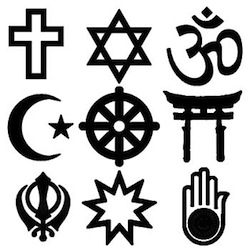
Unit 1: Redefining World Society and Culture
Lesson B: Division and Diffusion — World Belief Systems
Lesson Overview
One of the characteristics of a civilization is to have an organized religion. Many of the religions and belief systems practiced in the world today have long histories. They originated or began in a central location and through trade and other cultural exchanges spread throughout regions and the world. At times, religions served as unifying forces. People who practiced the same religion were often connected through political and cultural ties. At the same time, religions began to evolve as people with new ideas and from diverse backgrounds approached religion differently in places throughout the world. This sometimes led to conflict and division.

Symbols of Different Belief Systems [1]
Key Questions
- How can I use historical data to help me think like a historian?
- Why did some religions and belief systems splinter (break) into different branches?
- How did cultural diffusion lead to the spread of religions and belief systems?
- How have religion and belief systems served as both unifying and dividing forces in world history?
Student Outcomes
- Compare the fundamental teachings, practices, and divisions found in Judaism, Christianity, Islam, Hinduism, Buddhism, Confucianism, and Daoism.
- Analyze how cultural diffusion led to the spread of Christianity throughout the Roman and Byzantine worlds, Islam throughout southwest Asia and Africa, and Buddhism throughout eastern Asia.
- Explain the divisions that emerged within world religions, such as Catholicism and Eastern Orthodox Christianity, Sunni and Shi'ite Islam, and different forms of Buddhism and Confucianism.
- Compare the impact of religion on political affairs, such as the impact of Christianity in European nations, Islam throughout the Middle East, and Buddhism, Daoism, and Confucianism in East Asia.
- Analyze the impact of religion as a unifying cultural and social force, such as the role of Christianity in Europe and the role of Islam in the Islamic world.
- Use timelines, bar graphs, pie graphs, charts, and historical maps to evaluate historical data and recognize historical trends. (Historical Thinking Skill)
Key Terms
Student Resources
- World Religions and Belief Systems Comparison Charts (doc)
- Historical Investigation — The Relationship Between Religion and the Government (doc)
- World Religions and Belief Systems Brief Constructed Response (BCR) (doc)
Chart of Activities
| Activities to Complete | Estimated Time |
|---|---|
| Pre-Assessment | 5 minutes |
| Key Terms | 5 minutes |
| Activator: The World Religions | 5 minutes |
| Opening: Looking at World Belief Systems and Religions | 10 minutes |
| Activity 1: Using Timelines | 10 minutes |
| Activity 2: Tracing the Emergence of World Religions | 10 minutes |
| Activity 3: World Religions and Belief Systems | 10 minutes |
| Activity 4: Using Graphs and Charts | 10 minutes |
| Activity 5: Comparing Maps, Charts and Graphs | 10 minutes |
| Activity 6: Comparing Timelines and Maps | 10 minutes |
| Activity 7: Cultural Diffusion | 10 minutes |
| Activity 8: Unity and Division in Christianity | 10 minutes |
| Activity 9: Unity and Division in Islam and Buddhism | 10 minutes |
| Activity 10: Relationship Between Religions and Governments | 10 minutes |
| Activity 11: Conflicts in World Religions | 10 minutes |
| Review and Assessment | 10 minutes |
| Lesson Summary | 5 minutes |
Lesson Completion Time
The total estimated time to complete this lesson is 150 minutes.
Page Notes:
[1] Source: This image from http://commons.wikimedia.org/wiki/File:Religious_syms.png is in the public domain.

